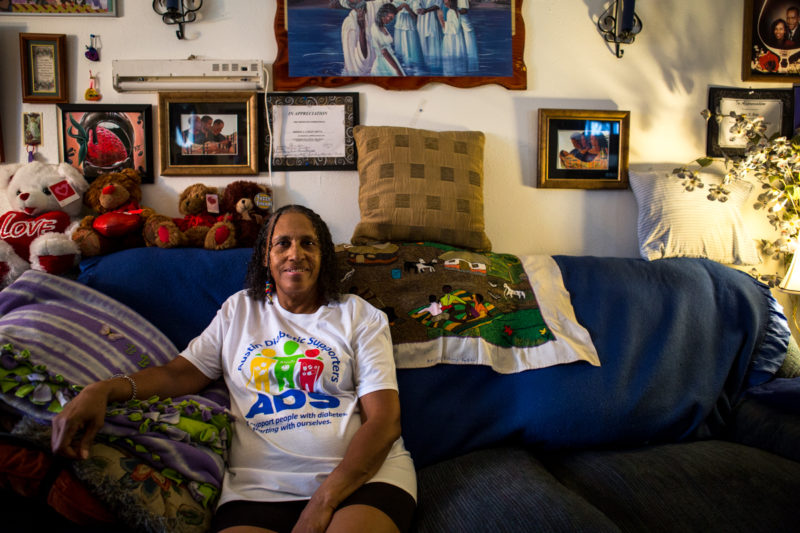Hospice Austin Works to Break Down Barriers
By Kaulie Lewis
Reporting Texas

Brenda Conley-Batts, a former hospice patient, at her home in Austin. Emree Weaver/Reporting Texas
Brenda Conley-Betts’ 45-year career as a nurse ended when she received a stage 3 non-Hodgkin lymphoma diagnosis in August 2013. She had loved working in the cardiac and intensive care units. Now, she was the one who needed care.
Her doctors immediately started an aggressive series of chemo treatments, but Conley-Batts’ body couldn’t take it. After the first treatment, she ended up in the emergency room and stayed at the hospital for 10 days; after the second, she was in the hospital for three months.
So Conley-Batts, 67, and her doctors decided to discontinue the treatments, believing they were causing her more harm than good. She was given three months to live, set up with Hospice Austin and sent home to spend her remaining time surrounded by friends and family.
“That’s where it all began,” Conley-Batts said.
Hospice Austin, the oldest hospice service in the city and the only nonprofit, cared for Conley-Batts and almost 2,000 other patients in 2015 alone. The organization annually offers almost $2 million in charity care, and unlike other hospice providers, Hospice Austin puts no cap on the number of unfunded patients it accepts. Even so, a disproportionate majority of clients from across the organization are white, leaving minority communities underserved.
Hospice Austin is aware of this service gap, communications coordinator Melinda Marble said, and is making an effort to reach families and communities that historically have been neglected by the wider medical community.
Now they have an unlikely ally — Conley-Batts.
While on in-home hospice care and without pursuing any life-prolonging treatment, Conley-Batts slowly began regaining her strength, surprising her doctors and family. A test last December showed her inexplicably cancer-free, and she’s been in remission ever since. With her improving health, she’s found a new purpose: getting the word out about the importance of hospice care and Hospice Austin.
“I still try to keep my hands in every opportunity that I have to make people and the community aware of hospice,” she said. “I want to get the word out any way I can.”
That’s easier said than done. There are a number of cultural barriers that can keep black and Latino families in need away from hospice care, Marble explained.
“There’s a suspicion of the medical community and traditions of family-based care,” she said.
Conley-Batts sees a similar gap in people’s understanding of the power of hospice care.
“I think that a lot of people have heard of it and know a little bit about it, but really don’t know the extent of what hospice does and how they do what they do until they get involved in some way, as a client or a volunteer,” she said.
Now Hospice Austin is trying to reach even more minority patients with the help of partners like Hospice Foundation of America. This organization is sending copies of a Frontline documentary, “Being Mortal,” and related outreach materials to hospice programs across the country, including Hospice Austin. Screenings of the documentary have been scheduled at sites around Austin throughout the spring and are followed by discussions about the role hospice care can play at the end of life.
But at the first screening, which took place at Westover Hills Church of Christ, the audience didn’t reflect the diversity Hospice Austin is hoping to encourage. Every attendee was white, and most seemed familiar with the specifics of hospice care. Many were Hospice Austin volunteers familiar with the organization.
“We’re kind of approaching this project a little cautiously at first until we get the first few under our belts,” Marble said. “But I really do envision this as a really good way to inform minority communities about the importance of planning for the future.
“The important thing for everyone is to get educated about this topic because with education comes empowerment.”
In addition to formal outreach campaigns, Hospice Austin has other strategies for reaching people and communities in need of services. The organization hires bilingual staff and recruits bilingual volunteers as often as possible, relying on word of mouth and greater accessibility to bring in traditionally underserved communities.
“In my opinion, I think there’s still a stigma about talking about hospice,” said Juan Perez, who is a Hospice Austin volunteer. “Not many people feel really comfortable talking about or thinking that they need to go into hospice or move a relative or their family, maybe just because they don’t know all the services that Hospice offers.”
During his time as a volunteer, Perez has seen the change that often comes as clients and families who were skeptical of hospice services begin to see the benefits.
“They’re just so grateful,” he said. “It’s a good relief and comes from seeing things in a different way than before when they were uninformed.”
Hospice Austin is hoping that clients and families who experience this relief will share their stories with others in their communities.
“Word of mouth has the most powerful influence on people’s attitudes,” Marble said. “As more people access hospice care and talk about the difference it made for their family, it encourages others to be open.”
Conley-Batts knows this is true. It’s why she puts such effort into sharing her Hospice Austin experience, helping to organize events at her church and speaking often with students and families.
“They make me feel like I’m important,” she said. “They make me feel like they really care about me, not just that I was a client but that they still care about me like I’m an individual. That’s important to me, and I think that would be important to other people who are struggling with death and dying.”